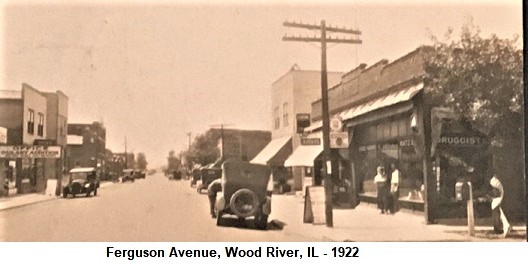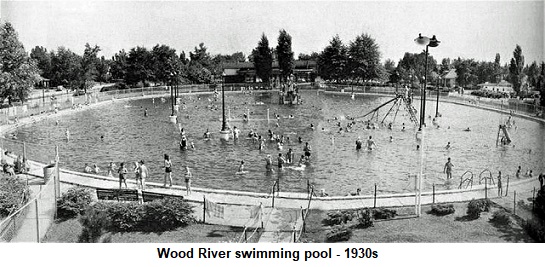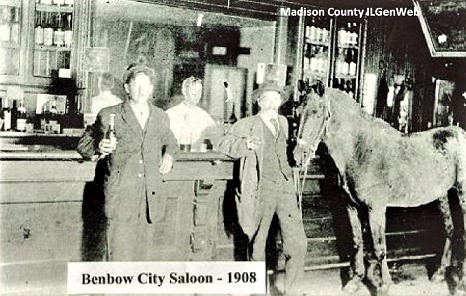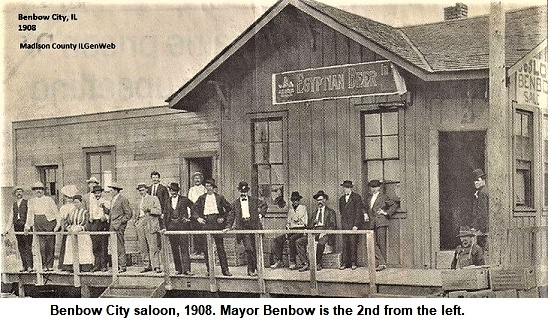Early History of Wood River (and Benbow City)
Wood River Newspaper Articles | Benbow City Newspaper Articles
The land that would be the future site of the town of Wood River was located in the American Bottoms – rich with sandy, loamy soil and small lakes. The township was named after the Wood River, which meandered throughout the area, emptying in the Mississippi. Settlers such as Zephaniah Job, the Vaughns, Hallers, Smiths, Heads, Kendalls, and Gillhams came from the East and established their farms. Milton was the first town established in Wood River Township, followed by Upper Alton and East Alton.
Founding of Wood
River
In 1906, Standard Oil engineers from Whiting, Indiana, searched the
fertile farmland along the Mississippi River to select a site for
their new refinery. The site selected was part of the Fred Penning
farm in Wood River Township, just west of the Big Four and the
Chicago, Peoria, and St. Louis Railroad lines. Construction began on
the refinery in 1907. The founding of the refinery meant workers
would need a place to live. In May 1907, Fred Penning platted his
farmland, which included land between Ferguson and Madison from
Fourth Street, past the intersection at First Street. On August 12,
1907, he added another subdivision, and on September 10, 1907, the
Riverview Subdivision was recorded. The following March 1908,
Penning completed the subdivision to Fourth Street, and on March 4,
the first Dulany’s subdivision was recorded. A petition for
incorporation of Wood River into a village was filed July 03, 1908
and was approved by Judge Hillskotter. The election was held October
6, 1908. Parke E. Ashlock (son of James T. Ashlock) was elected
village president; M. W. Taylor, Village Clerk; and James T. Ashlock
was elected police magistrate.
Progress
Even with this rapid development, as soon as a house was built, a
family moved in. Water, sewers, and electricity were not yet
available. Madison Avenue, constructed by the Standard Oil Company,
was covered with rock and was the only good road in town. All other
roads were loose sand, in which horses had a terrible time pulling
wagons through.
The eastern portion of the area was growing also. Augustine Head
owned a farm bounded on the east by Thirteenth Street, the west by
Sixth Street, the south by Tydeman in Roxana, and on the north by
Madison. The Head farmhouse stood on the corner of Ninth and
Whittier. Head began to sell some of his farmland to the Standard
Oil Company for workers who needed homes. This eastern portion and
the original western portion of Wood River soon became rivals.
Incorporation
During 1909, it was decided to incorporate, and a petition was
presented to incorporate the eastern section under the name of East
Wood River. The incorporation was approved, and election of officers
was held. It was

As the refinery grew, the population of the area increased. Standard
Oil purchased for their workers more than two dozen Sears catalog
kit homes in 1919. The close relationship between the refinery and
the city was evidenced by the fact that the sports teams for the
Wood River schools were named the Oilers, in honor of the industry
that gave birth to their community.
In 1926, Standard Oil donated what was then the nation’s largest
outdoor swimming pool, along with a community center known as the
Roundhouse, and a wooden band shell. A Standard Oil official was the
first person to enter the pool, located on Whitelaw Avenue.

Early Wood River
Schools
Education began in the future site of Wood River with the
construction of Gillham’s Pasture School on the northeast corner of
what is now 13th Street and Edwardsville Road in Wood River.
In the early 1860s, the Brushy Grove School was erected where the
Gillham Pasture School stood. Brushy Grove was originally in the
Roxana School District. The first schoolhouse was destroyed by fire
and was replaced. A third structure was erected when state laws
regulated systems of ventilation and sanitation, which the second
building lacked. This schoolhouse was sold to Joseph Havelka, Wood
River Township Road Supervisor, for $425. The fourth Brushy Grove
School was completed November 1929, and was a modern, four-classroom
building. The fourth schoolhouse was torn down in 1971. Today, a
marker stands at the U. S. Bank (formerly the Wood River Savings and
Loan) where the Brushy Grove church and school were located. This
marker was dedicated in November 1984. The cornerstone of the fourth
schoolhouse and the stone nameplate were incorporated into the
marker.
In 1911, Standard Oil erected the first school in the city of Wood
River. It was located on North Old St. Louis Road, just north of
West Ferguson Avenue.
Early Wood River
Churches
The first church in the area, north of the future site of the town
of Wood River, was on Vaughn Hill. Named the Wood River Church, it
was established on May 31, 1807, by Elders William Jones and David
Badgley, with thirteen charter members: Elder William Jones,
Elizabeth Jones, Susan Brown, Isaac Hill, Lucy Hill, John Finley,
Mary Finley, Joseph Cook, Sarah Cook, John Rattan, Mary Rattan, Anne
Rose, and William Stubblefield. This was the sixth Baptist Church
organized in Illinois Territory. In June 1809, Abel, Moore, Mary
Moore, James Beeman, and Nancy Beeman were received into the church
by letter. In June 1815, James Beeman was appointed to secure lumber
to floor the meetinghouse, and purchase two acres of land from
Joseph Vaughn for the building and cemetery (named the Vaughn
Cemetery).
The Brushy Grove Church was dedicated in about December 1887. It was
completed earlier, but the dedication was postponed due to inclement
weather. A fund raiser was held in February 1889, to purchase an
organ for the church. By 1916, there were rumors the Brushy Grove
Church and school were slated to be torn down due to lack of use.
The First Baptist Church of Wood River was organized June 10, 1916,
in the home of Mr. and Mrs. Arthur Herr, who lived on Lorena Avenue.
For about five months, the church held regular meetings over Max
Nissenholtz’s shoe store on Ferguson Avenue. During this time, the
first church building, known as the Tabernacle, was erected on
Second and Acton Streets. It was a one-room frame building, and was
dedicated November 26, 1916. Rev. D. C. Blunt was the first pastor.
Work began on a new church building in 1921. The basement was
finished and used for services until the remainder of the building
was completed in 1922. Mr. John Sullivan was the contractor, and the
building cost $20,000. Must of the finishing work was done by church
members. In April 1958, plans were made for the construction of a
new educational building, which was completed in 1961.
On January 29, 1920, St. John Evangelical Church was organized with
thirty-two members, with Harry Lenhardt as president. On October 21,
1928, a new church was completed, and remodeled in 1991.
BENBOW CITY
Benbow City in Wood River Township was founded in December 1907 by
Amos Benbow, a 60-year-old former school teacher and realtor, who
 inherited land near the future Standard Oil Refinery in Wood River
Township. He was the son of Richard M. Benbow, and was born in Wood
River Township on February 20, 1850.
inherited land near the future Standard Oil Refinery in Wood River
Township. He was the son of Richard M. Benbow, and was born in Wood
River Township on February 20, 1850.
Benbow City was located north and south of present-day Hwy. 143 in
Wood River, just east of the railroad tracks near Rt. 3. The
property had previously been farmland. Just to the west of Benbow
City was an area called Little Italy, which was occupied by mostly
foreigners. Benbow City was developed for refinery workers, who
turned it into a lawless town with mostly saloons and prostitution.
It had a peak population of about 300 people, with one saloon for
each thirteen people. In addition to the twenty-three saloons, there
were seven brewery agencies, and each dram shop and agency paid $500
a year for a license.
After founding Benbow City, Amos Benbow was elected mayor. As head
of that town, he made his famous fight against the encroachment of
the city of Wood River, insisting his place was Benbow City, not
part of Wood River. Several destructive fires led to the downfall of
Benbow City. Several years later, Benbow disposed of some of his
land to the Standard Oil Company, and in 1917 Benbow City ceased to
exist and was annexed into Wood River.
Other public offices Benbow held included two terms as mayor of
Upper Alton, constable, justice of the peace, assessor, collector
and deputy sheriff. He represented his district in the Forty-fourth
Illinois General Assembly. During President Cleveland's first
administration, he was Deputy United States Marshal, for the
Southern Illinois district, which included 69 counties.

William O’Hearn, a former St. Louis policeman, was a councilman at
Benbow City. He also tended bar at the Marsh Saloon there. He became
ill while tending bar in August 1913, and was taken by John Brady
and Jerome Ford, Benbow City marshals, to the village hall, where
Dr. E. D. Gottshalk attended him. He died August 27, 1913. O’Hearn
was known as the “handy man” of Benbow City. When the Mayor was
absent, O’Hearn filled in. At various times he served as marshal,
village clerk, election judge, and fire department volunteer.
Mrs. Katie Waggoner was the first woman to live in Benbow City. She
settled in a box car (where a lot of the foreigners lived before
housing was available) and did cooking for the foreigners who worked
at the nearby refinery. In her spare time, she served as translator,
as she was fluent in five tongues – Polish, Slavish, Hungarian,
German, and English. She was highly regarded, described as pretty,
and dressed neatly. She later moved into a tent, and then married
Michael Waggoner, a foreigner working at the refinery. They bought a
house together. In June 1912, Katie died at her home of Bright’s
disease (inflammation of the kidneys), and is buried in the
Greenwood (St. Patrick’s) Cemetery in Godfrey.
